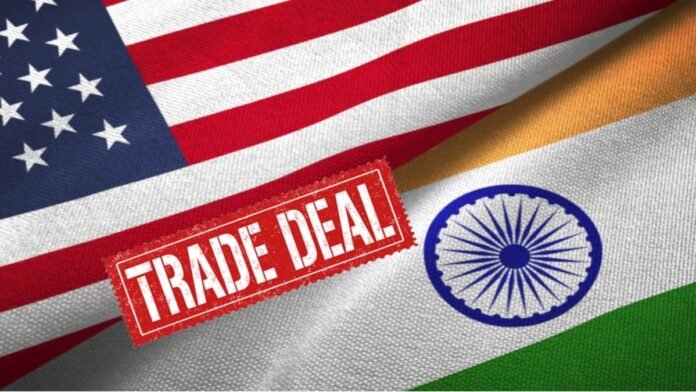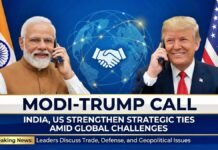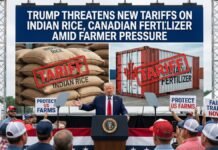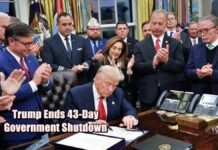
Key Points
- US President Donald Trump announced Wednesday that a long-delayed trade deal with India will be signed “soon,” speaking at APEC CEO luncheon in Gyeongju, South Korea
- Negotiations are reportedly in “final stages,” with US tariffs on Indian exports potentially dropping from 50% to 15-16%
- India has agreed to scale back purchases of Russian crude oil as part of the compromise, though exact reduction targets remain undisclosed
- The deal could include limited imports of non-genetically modified (non-GM) American corn and soymeal to India’s protected agricultural market
- Current 50% US tariff includes 25% base rate plus 25% “penalty” imposed for India’s Russian oil purchases supporting Moscow’s war effort
- India currently imports about one-third of its crude oil from Russia at discounted prices, making it a key revenue source for Moscow
- Proposed agreement would include periodic review mechanism for tariffs and market access adjustments
- US is India’s largest trading partner for four consecutive years, with bilateral trade reaching $131.8 billion in 2024-25
- External Affairs Minister S. Jaishankar met with US Secretary of State Marco Rubio this week in Kuala Lumpur to discuss negotiations
- India has maintained it will not accept any deal that negatively impacts millions of small farmers
Gyeongju: Speaking at the Asia-Pacific Economic Cooperation (APEC) CEO luncheon in Gyeongju, South Korea, on Wednesday, October 28, 2025, US President Donald Trump expressed strong confidence that the United States and India would soon finalize a long-delayed trade agreement that has been under negotiation for months. Trump’s remarks came during the final leg of his Asia tour and signal that a deal between two of the world’s largest economies may be imminent.
“If you look at India and Pakistan, so I’m doing a trade deal with India, and I have great respect and love for Prime Minister Narendra Modi… we have a great relationship,” Trump told the assembled business leaders. He emphasized his personal rapport with the Indian Prime Minister, stating definitively: “I am going to do a trade deal with India“.
Trump’s positive assessment came in the context of broader remarks about his administration’s trade policy successes. “We stopped a lot of wars, made our country strong,” Trump declared, adding that “around the world, we are signing one trade deal after another“. The President characterized the potential India agreement as part of his administration’s broader economic diplomacy achievements.
According to sources familiar with the discussions who spoke to The Economic Times, negotiations are in the final stages, with talks focused on the specific mechanisms for tariff reductions and corresponding Indian commitments on energy purchases and market access. “The contours of the deal are still being finalised,” one person aware of the talks confirmed.
The announcement represents a significant shift from the tense trade relationship that has characterized US-India economic ties in recent months, marked by punitive tariffs, disputes over energy policy, and stalled negotiations over agricultural market access.
Tariff Reduction: From 50% to 15-16%
The centerpiece of the proposed trade agreement involves a dramatic reduction in US tariffs on Indian exports, which currently stand at approximately 50% and have severely impacted Indian exporters’ competitiveness in the crucial American market. According to multiple reports citing sources familiar with the negotiations, the United States has agreed to slash tariffs to 15-16%, representing a reduction of more than two-thirds from current levels.
This 50% tariff rate comprises two components: a baseline tariff of approximately 25% applied to Indian goods generally, plus an additional 25% “penalty” tariff specifically imposed in response to India’s continued purchases of Russian crude oil. The Trump administration has argued that Indian oil imports are “helping to power Russia’s war machine” in Ukraine, justifying the punitive additional tariff as a mechanism to pressure New Delhi into reducing energy dependence on Moscow.
The proposed tariff reduction would provide significant relief for Indian exporters across multiple sectors, particularly textiles, pharmaceuticals, engineering products, seafood (especially shrimp), and manufactured goods that have struggled to maintain market share in the United States due to the high tariff burden. Indian stock markets responded positively to Trump’s announcement, with textile and shrimp stocks rising up to 4% on Wednesday following the news.
For context, the United States has been India’s largest trading partner for four consecutive years, with bilateral trade reaching $131.8 billion in the fiscal year 2024-25. The high tariff regime has threatened to undermine this extensive trade relationship, making tariff relief a critical priority for the Indian government.
Sources indicate that while the broad framework of tariff reduction has been agreed upon in principle, the specific implementation timeline and product categories covered by the reduced rates are still being finalized through technical negotiations. The agreement is also expected to include a periodic review mechanism that would allow both countries to adjust tariff levels and market access provisions based on evolving economic conditions and compliance with commitments.
The Russian Oil Commitment: India’s Strategic Concession
In exchange for the substantial tariff relief, India has reportedly agreed to gradually reduce its dependence on Russian crude oil, though the exact reduction targets and timeline have not been publicly disclosed. This commitment represents a significant strategic concession from New Delhi, which has steadfastly defended its right to purchase energy from any source based on its national interests.
India currently imports approximately one-third of its crude oil from Russia, a substantial portion of the country’s total energy needs. These Russian oil purchases have provided India with access to discounted crude oil at prices significantly below international benchmarks, helping to control inflation and reduce the country’s import bill during a period of elevated global energy prices.
For Washington, encouraging India to diversify away from Russian oil serves both commercial and geopolitical objectives. The move aims to tighten global enforcement of sanctions on Moscow by reducing one of Russia’s key export revenues, while simultaneously deepening the strategic partnership between the United States and India. By reducing Russian oil revenues, the US hopes to constrain Moscow’s ability to finance its military operations in Ukraine.
The compromise on Russian oil reflects India’s recognition that maintaining access to the crucial American market justifies some adjustment in its energy sourcing strategy, though New Delhi has been careful to frame this as a gradual transition rather than an immediate cessation of Russian purchases. This approach allows India to maintain strategic autonomy while addressing American concerns about inadvertently supporting Russia’s war effort.
According to reports, India has already begun discussions with alternative oil suppliers, including Middle Eastern producers and potentially American liquefied natural gas (LNG) exporters, to gradually replace Russian crude in its energy mix. However, the practical challenges of replacing such a large volume of discounted oil with more expensive alternatives will require careful economic management.
Agricultural Market Access: The Remaining Sticking Point
While progress has been made on tariffs and Russian oil, the third major sticking point, India’s reluctance to open its politically sensitive dairy and agriculture markets to American imports, remains a complex challenge. Agricultural sectors constitute a vital voter base for any Indian government, with millions of small and marginal farmers whose livelihoods depend on protection from cheaper foreign competition.
The proposed compromise could include limited access for US exports of non-genetically modified (non-GM) corn and soymeal, representing a carefully calibrated opening that addresses American demands without completely exposing Indian farmers to unrestricted competition. This distinction between GM and non-GM products is crucial for India, which has strict regulations prohibiting genetically modified food crops and bars ethanol production from imported grains.
India has increasingly turned to corn to boost ethanol output as part of its biofuels program aimed at reducing dependence on imported petroleum products. However, current Indian regulations prohibit using imported grains for ethanol production, creating a barrier to American corn exports. The United States mostly grows GM corn, though some American farmers also produce non-GM varieties that could qualify for the Indian market under the proposed agreement.
The US negotiating position argues that ethanol made from American corn would be used only for blending with petrol and would not enter agricultural markets where it could compete with Indian farmers’ produce. This “ring-fencing” approach attempts to address India’s concerns about market disruption while allowing American agricultural exports to access India’s growing biofuels sector.
The push on soybeans represents a different dynamic, emerging as a fallout from the US tariff war with China. American soybeans have become too expensive for Chinese buyers due to retaliatory tariffs, creating a surplus that Washington wants to redirect to alternative markets. The United States is pressing India to import this soybean surplus as protein-rich feed for the country’s large cattle population—India has more cattle than any other nation in the world.
However, the Indian government has maintained a firm position throughout these protracted negotiations that it will not accept any deal that could negatively impact the livelihoods of crores (tens of millions) of small farmers who form the backbone of the country’s agricultural economy and represent a politically crucial constituency.
India’s Red Lines: Jaishankar’s Firm Stance
External Affairs Minister S. Jaishankar has been explicit about India’s negotiating boundaries, emphasizing that any trade deal must respect India’s fundamental concerns and strategic interests. Earlier in October, Jaishankar stated that any agreement with the United States would have to respect India’s “red flags,” specifically referring to what he characterized as the “unfair” 25% penalty tariff imposed for purchasing Russian oil.
Jaishankar’s public articulation of these red lines reflects the Indian government’s need to balance economic benefits from improved US market access against domestic political imperatives and strategic autonomy. The Minister has consistently argued that India’s energy purchasing decisions should be based on national interest rather than external pressure, while acknowledging the value of the broader US-India partnership.
This week, Jaishankar met with US Secretary of State Marco Rubio in Kuala Lumpur to discuss international relations and the ongoing trade negotiations between their nations. While no breakthrough was officially announced following this meeting, sources suggest that the ministerial-level engagement helped resolve some remaining technical issues and built political momentum toward finalizing the agreement.
The Indian government’s approach throughout the negotiations has emphasized reciprocity and mutual benefit rather than one-sided concessions. New Delhi has resisted American demands that would require India to make substantial sacrifices without corresponding benefits, insisting on a balanced agreement that serves both countries’ economic interests.
Timeline and Implementation
According to sources familiar with the negotiations, both sides are aiming to formalize the proposed Bilateral Trade Agreement (BTA) by late 2025. Trump’s confident assertion that a deal is imminent suggests that the final technical details are being resolved and that an announcement could come within weeks rather than months.
The formal announcement of the trade deal is expected to occur during an upcoming high-level meeting between President Trump and Prime Minister Modi, though the exact timing and venue have not been confirmed. Earlier reports suggested the announcement might coincide with the ASEAN summit or another regional gathering where both leaders would be present.
However, it’s worth noting that Prime Minister Modi deliberately skipped the ASEAN summit in Malaysia this week, reportedly to avoid encountering Trump and being subjected to the US President’s repeated claims about mediating the India-Pakistan conflict. This absence suggests that Indian officials may prefer to announce any trade agreement through carefully choreographed diplomatic channels rather than informal summit interactions.
Once announced, the agreement would likely require technical implementation through regulatory changes, customs notifications, and administrative adjustments on both sides before the tariff reductions take full effect. The periodic review mechanism would be established to allow both governments to monitor compliance and make adjustments as economic conditions evolve.
Trump’s Controversial India-Pakistan Claims
Trump’s APEC remarks about the trade deal were embedded within controversial claims about his role in resolving the India-Pakistan conflict in May 2025—assertions that India has repeatedly and categorically denied. According to Trump’s account, he threatened both nations with refusing to pursue trade deals and imposing 250% tariffs unless they ceased hostilities.
“I called Prime Minister Modi and said, ‘We can’t make a trade deal with you. No, no, we must make a trade deal.’ I said, ‘No, we can’t. You’re starting a war with Pakistan. We’re not going to do it,'” Trump recounted. He claimed to have delivered a similar ultimatum to Pakistani leadership: “Then I called Pakistan and said, ‘We’re not going to do trade with you because you’re fighting with India‘”.
Trump asserted that his threat of 250% tariffs, which he characterized as “a nice way of saying we don’t want to do business with you,” forced both nuclear-armed nations to step back from conflict. “After literally two days, they called up and they said, ‘We understand,’ and they stopped fighting,” Trump claimed.
However, India has unequivocally rejected this narrative, maintaining that the May ceasefire was reached through direct bilateral military and diplomatic channels with no US involvement. According to Indian officials, the decision to de-escalate was made after a request from the Pakistani Director General of Military Operations to his Indian counterpart, following standard military-to-military communication protocols.
Prime Minister Modi himself directly contradicted Trump’s version of events during a June phone conversation, though the US President has continued to repeat and embellish the claim in subsequent speeches. The persistent repetition of what Indian officials view as a false narrative has become a source of frustration in the bilateral relationship.
Economic and Strategic Implications
If successfully concluded, the US-India trade agreement would represent the most substantial trade breakthrough between the two nations in recent years, following a prolonged period of tariff disputes, stalled negotiations, and deteriorating economic relations. The deal carries implications far beyond the immediate commercial benefits, touching on geopolitical alignment, energy security, and the broader US strategy in the Indo-Pacific region.
For Indian exporters, the tariff reduction from 50% to 15-16% would dramatically improve competitiveness in the American market across multiple sectors. The textile industry, pharmaceutical manufacturers, engineering goods exporters, and seafood processors would all benefit substantially from lower tariff barriers. The positive stock market reaction—with textile and shrimp stocks rising up to 4% following Trump’s announcement reflects investor optimism about improved export prospects.
For American agricultural exporters, gaining even limited access to India’s vast market for corn and soymeal represents a significant commercial opportunity, particularly given the displacement of US agricultural products from the Chinese market due to ongoing trade tensions. The ability to sell non-GM corn for India’s expanding biofuels program could create substantial revenue streams for American farmers.
The geopolitical dimension centers on India’s gradual reduction of Russian oil imports, which serves American strategic objectives of isolating Moscow and reducing its revenue from energy exports. By encouraging India to diversify its energy sources, Washington aims to tighten the economic pressure on Russia while deepening its own strategic partnership with New Delhi as a counterweight to Chinese influence in the Indo-Pacific.
However, the deal also carries risks and challenges for both sides. For India, replacing discounted Russian oil with more expensive alternatives could increase inflation and widen the current account deficit. The limited opening of agricultural markets, even if carefully ring-fenced, creates political vulnerabilities with farming communities that represent crucial electoral constituencies.
For the United States, the substantial tariff reduction represents forgone revenue and could face domestic political criticism from those who argue that India should make more comprehensive concessions on market access before receiving such generous treatment. The compromise nature of the agricultural provisions—limited to non-GM products and specific uses—falls short of the comprehensive market access that some American agricultural lobbies have demanded.
Broader US-India Partnership
The trade agreement, if successfully concluded, would provide a positive foundation for the broader strategic partnership between the world’s oldest and largest democracies. Beyond trade, the two nations cooperate extensively in defense, counterterrorism, technology development, space exploration, and regional security through frameworks like the Quad partnership (alongside Japan and Australia).
Both countries share fundamental concerns about China’s growing military and economic influence in the Indo-Pacific region, creating strong strategic rationale for maintaining close ties despite periodic disagreements over specific policy issues. India’s role as a democratic counterweight to Chinese power makes it a valuable partner for the United States, while India benefits from American technology transfers, investment, and diplomatic support.
The defense relationship has deepened significantly in recent years, with India purchasing advanced American military equipment including maritime patrol aircraft, transport planes, and potentially fighter jets in future deals. Joint military exercises, intelligence sharing, and defense technology cooperation provide stabilizing factors in the relationship that can help weather temporary storms caused by trade disputes or rhetorical controversies.
However, the relationship faces ongoing challenges from Trump’s transactional approach to foreign policy, which views partnerships primarily through the lens of trade balances, deal-making opportunities, and personal rapport with foreign leaders. His tendency to publicly criticize allies, make exaggerated claims about his diplomatic achievements, and threaten economic consequences creates unpredictability that complicates traditional diplomatic management.
The fact that Modi deliberately avoided the ASEAN summit to prevent Trump from repeating his India-Pakistan ceasefire claims in person underscores the strain that Trump’s rhetoric has placed on the relationship. Indian officials must balance the strategic and economic importance of the US partnership against the need to correct misleading narratives and protect India’s image as a sovereign nation making independent decisions.
Market Reactions and Stakeholder Perspectives
Indian financial markets responded positively to Trump’s announcement of an imminent trade deal, with sectors expected to benefit most from tariff reductions experiencing immediate stock price increases. Textile manufacturers and shrimp exporters saw share prices rise by up to 4% on Wednesday following the news, reflecting investor optimism about improved export competitiveness once tariffs are reduced.
However, agricultural stakeholders in India have expressed concerns about even limited market opening for American corn and soymeal, fearing that this could be the “thin edge of the wedge” leading to more comprehensive market liberalization in future negotiations. Farmer organizations and agricultural advocacy groups have called on the government to ensure that any commitments made in the trade deal do not compromise the livelihoods of millions of small and marginal farmers.
American agricultural lobbies have expressed cautious optimism about gaining access to the Indian market for non-GM corn and soymeal, though some have criticized the limitations as insufficient and called for more comprehensive agricultural market liberalization. The US dairy industry, which has long sought access to India’s large milk-consuming market, appears to have been left out of the current agreement framework.
Energy sector analysts note that India’s commitment to reduce Russian oil imports will create opportunities for alternative suppliers, including Middle Eastern producers and potentially American LNG exporters. However, the practical challenges of replacing such large volumes of discounted Russian oil with more expensive alternatives will require significant adjustments to India’s energy import strategy and could have inflationary implications.
As negotiations enter their final stages and both governments work toward formalizing the agreement by late 2025, stakeholders across multiple sectors in both countries will be closely watching for details of the implementation timeline, specific product coverage, and the mechanisms for periodic review and adjustment.



















































